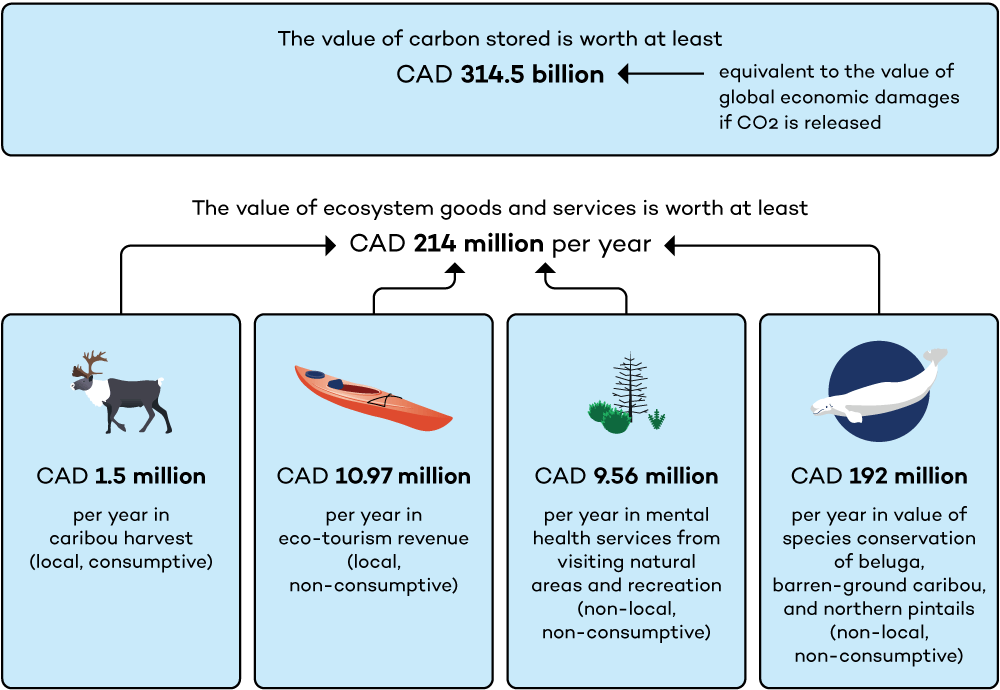
A Value on the Priceless: Ecological goods and services generated in the Seal River Watershed
This report assesses the economic value of ecosystem benefits provided by the Seal River Watershed, a large pristine region located in Northern Manitoba, Canada. The Seal River Watershed is not impacted by dams, industrial development, or forestry. It maintains clean water, is home to abundant wildlife, and supports the livelihoods and culture of Dene, Cree, and Inuit people. To stop and reverse global biodiversity loss and limit climate warming, it is critical to protect the world's last remaining intact regions like the Seal River Watershed.
-
The Seal River Watershed provides at minimum CAD 214 million worth of ecosystem goods and services annually.
-
The importance and value of ecosystem goods and services provided by the Seal River Watershed will increase as we are faced with the global decline of intact forest ecosystems and the global decline in biodiversity, which reinforces the need for its protection.
-
A fully functioning, ecologically intact watershed that is sustainably managed and monitored by Indigenous stewards will help contribute to our action on climate mitigation, resiliency, and biodiversity conservation.
Articulating the values of intact regions in monetary terms is one way to demonstrate how they benefit local and global communities. Economic valuations inform decision-makers and help strengthen the case for conservation. They also identify data and monitoring needs.
The International Institute for Sustainable Development partnered with the Seal River Watershed Alliance and the Canadian Parks and Wilderness Society Manitoba Chapter in a project to assess the economic value of ecosystem benefits provided by the Seal River Watershed.
Our study found that in the Seal River Watershed:

This is a partial valuation based on the available data and economic valuation methods. Efforts are already underway to protect the entire watershed as an Indigenous Protected Area (IPA) led by the Sayisi Dene First Nation and supported by the Cree, Dene, and Inuit neighbours. The IPA model allows local Indigenous communities to chart their own path for the stewardship of the Seal River Watershed based on local and Traditional Knowledge and sustain the watershed’s people, culture, and animals into the future. Protecting the Seal River Watershed would add 0.5% to Canada’s protected areas targets.
Participating experts
You might also be interested in
The Critical Next Step: What you need to know about Canada’s 2030 climate target
Canada's climate target for 2030 is within reach, but more stringent policies and clearer government communication will be needed to get there. Our expert explains why these developments are critical for Canada to help avoid the worst impacts of climate change.
Ottawa supports Big Oil over the climate
One can only imagine the positive buzz these days inside the boardrooms of Canada's oil companies, as they rake in record profits and plan major expansions of their oil production. Amid all the good cheer, one could easily lose sight of the fact that those plans will push the world dangerously closer to the brink of irreversible climate chaos. Even as the world finally signed a commitment at UN climate talks last month to begin transitioning away from fossil fuels, Canada's major oil companies are poised to do exactly the opposite — to greatly expand their fossil fuel production.
What’s Next After UNEA-6: Why “synergies” is more than a buzzword
In an era marked by escalating environmental challenges and geopolitical tension, the Sixth United Nations Environment Assembly (UNEA-6) called for more cooperation to tackle the triple planetary crisis.
What Is the UAE Framework for Global Climate Resilience, and How Can Countries Move It Forward?
With the introduction of the new framework for the Global Goal on Adaptation (GGA), COP 28 marked a milestone for adaptation. We unpack key outputs and set out how countries can move forward by strengthening their national monitoring, evaluation, and learning (MEL) systems.